
PEACE RIVER ELECTRIC COOPERATIVE JANUARY 2024







•
•











PEACE RIVER ELECTRIC COOPERATIVE JANUARY 2024







•
•









January 2024 • Volume 13, No. 3
CEO Michael Shepard
VICE PRESIDENT OF CONTENT Leon Espinoza
EDITORIAL DIRECTOR Mike Teegarden, CCC
DEPUTY EDITORIAL DIRECTOR
Noble Sprayberry
SENIOR EDITOR Jennifer Paton, CCC
FLORIDA CURRENTS EDITORS
Chasity Anderson, CCC; Valeri Pearon
ASSISTANT EDITORS Victoria Hampton, CCC;
David Herder, CCC
ASSOCIATE EDITOR
Nina Todea
PUBLICATIONS PRODUCTION MANAGER
Elizabeth Beatty
PUBLICATIONS COORDINATOR
Alyssa McDougle
Members acknowledge that $4.31 a year, plus postage, is the cost to publish 12 issues a year of FLORIDA CURRENTS ISSN 23276304 (USPS 8300). Published by Pioneer Utility Resources Inc., 5625 NE Elam Young Pkwy. Ste. 100, Hillsboro, OR 97124—a not-for-profit Oregon cooperative corporation—the magazine serves the communication needs of consumerowned electric utilities in Florida. Preferred Periodicals postage paid at Hillsboro, OR 97123 and at additional mailing offices.
Postmaster: Send address changes to 5625 NE Elam Young Pkwy., Ste. 100, Hillsboro, OR 97124-6422.
HOW TO CONTACT FLORIDA CURRENTS
Subscription services:
Nonmember subscriptions $15 U.S. a year; $25 foreign a year. Prepayment required. Allow 4-8 weeks for first issue. Identify local edition desired. Have a problem receiving your magazine? Utility members should contact their utility office. Nonmembers call 503-357-2105 or email mailingdept@pioneer.coop.
Back issues:
Back issues and extra copies are $3 each, prepayment required. Supply is limited. Identify edition, month and year. Call first to check availability. Contact Pioneer Utility Resources: P.O. Box 1306, North Plains, OR 97133-1306; 503-357-2105; email: mailingdept@pioneer.coop.
DISPLAY ADVERTISING INQUIRIES
American MainStreet Publications 611 S. Congress Ave. Ste. 504 Austin, TX 78704-1714; 800-626-1181 or 512-441-5200; amp.coop.
© 2024 Pioneer Utility Resources. All rights reserved. Reproduction in whole or in part without written permission is prohibited. Direct reprint requests to editor@floridacurrents.com. For more information, visit www.pioneer.coop.
For additional content, search @FloridaCurrents on your favorite social media sites and floridacurrents.com.

It is amazing to see how much of Florida is powered by member-owned cooperative utilities. We are proud to be a part of the Florida Electric Cooperative Association, which serves approximately 2.7 million Floridians in 57 of the state’s 67 counties. Learn more at feca.com/members.

Creating a Sea Urchin Nursery Florida Keys research may help protect Caribbean reefs Up Close, Page 10
Esports growth offers Florida students community and opportunity Spotlight, Page 12

Online applications due by February 29
Whether you plan to attend a college, trade school or university in 2024, don’t miss this incredible opportunity! Peace River Electric Cooperative wants to help you pay for school.



PRECO is granting $106,000 in valuable scholarships to help diligent and ambitious students achieve their academic goals.


It doesn’t matter if you’re currently a high school senior, a student already attending college or an adult of any age seeking to improve your job opportunities, PRECO invites you to apply for our Operation Round Up scholarship program.
• Eligibility: PRECO members and their dependent children may apply.
• Application deadline: Apply at PRECO.coop between January 2 and February 29.
• Transcript: Your high school or college transcript must be received by mail by March 7.
• Some restrictions apply. See the scholarship application for details. Since 2006, Operation Round Up has granted $1,235,500 in scholarships to more than 250 students.
Pro Tip
Don’t wait until the last minute to ask your high school or college for a transcript. Processing can take time, so request yours early. Have your educational institution mail your transcript to Peace River Electric Cooperative Scholarship Committee, P.O. Box 1310, Wauchula, Florida 33873.


Don’t miss this amazing opportunity
Are you interested in American history, politics and electric cooperatives? If so, apply for Peace River Electric Cooperative’s Youth Tour today.
What is Youth Tour?
Youth Tour is an unforgettable trip to Washington, D.C., for high school juniors from across the country. As a Youth Tour delegate, you will experience American history up close and personal, learn how the United States political process works and discover why electric co-ops are important to the local community.
What will I do on Youth Tour?
• Visit iconic landmarks such as the White House, the Capitol and the Lincoln Memorial.
• Meet with elected officials.
• Make new friends from all over the country.
How can I apply for Youth Tour?
• Complete the online application at PRECO.coop.
• Submit a short essay and a letter of reference.

What are the eligibility requirements for Youth Tour?
• Must be an 11th-grade student.
• Reside in a home that PRECO serves.
• Have a minimum GPA of 3.0.


The deadline to apply is January 15. PRECO will select two students to attend Youth Tour all-expenses-paid.
For more information, please visit PRECO.coop and YouthTour.coop.

YOUTH TOUR: JUNE 16-21, 2024



















































































By David Herder








We can all think of improvements we would like to make in the new year, whether it is eating healthier, volunteering more or lowering our expenses. One way to spend less in the new year and for many more to come is to make household energy efficiency a goal.
Making small changes to your routine can add up to significant savings. But do you know what adds up faster than small things?
Big things.
If you’re willing to make the initial investment, resolve to go big by taking on one of these projects.
For most houses, heating and cooling air makes up the largest chunk of energy use. If you’re paying to heat or cool the air, you want to keep it inside your house.
Common spots to insulate are attics, walls, floors and anywhere your house contacts the outside. Just like you want a jacket between you and the cold, you want insulation between your home and the outdoors.
Insulation is rated in R-values. The minimum suggested attic insulation R-value for Florida is R-30. In many cases, it is a good idea to get professional insulation help.
Air sealing is another step to prevent drafts by physically closing gaps and cracks. In some cases, this can be as simple as adding caulking or weatherstripping to places where you notice drafts.
Peace River Electric Cooperative offers members free home energy audits. Call the Energy Services Department at 800-282-3824 for more information.
If you’re considering doing some air sealing on your own, the Department of Energy offers tips at www.energy.gov/energysaver/air-sealing-your-home.
What are windows but walls you can see through? Like outer walls, they touch the outdoors, and unlike many walls, they aren’t filled with thick insulation. Heat gain and loss through windows account for 25% to 30% of residential heating and cooling costs, according to the Department of Energy.
Energy Star windows typically have high U-factors, a


































































































measurement of how well they insulate. Get multiple quotes for any home improvement project, including windows, and be on the lookout for rebates from utilities, state programs and the federal government.






































If you aren’t buying new windows right away, consider steppingstones such as adding weatherstripping, caulking gaps and using thermal drapes.















Just like you don’t want your heated and cooled air to leak outdoors, you don’t want your air leaking into parts of the house where you never go.






If you have ductwork in an attic, crawlspace or other unairconditioned or heated area, the ducts could have leaks that increase your energy bill. According to the Department of Energy, 20% to 30% of the air moved through ducts is lost to leakage.
Hire a professional to seal your ducts, or seal them yourself with metal tape or duct mastic specifically designed for the job. Do not use duct tape, which will dry out and lose adhesion.
So far, we’ve covered three ways to keep your heated and cooled air where you want it. It turns out, how you heat or cool the air is also important.
If you’re willing to replace your furnace, or the unit is 10-plus years old, a heat pump is an efficient home heating and cooling upgrade. It can reduce heating costs by as much as 50% compared to electric resistance heating, according to the Department of Energy.
A heat pump works similarly to an air conditioner in reverse. It uses a refrigerant to pull heat energy out of the air outdoors, then moves it indoors and blows the heat into your living areas. Also consider a heat pump water heater, which has all the same advantages but heats water rather than air.
If a heater turns on, but nobody is there to hear it, does it make a noise? One thing we know is that it would impact your energy bill.
































































































Before starting a project, it is important to take a step back and consider, “What will make the biggest impact?” This means knowing how efficient your house is and where the energy use is going.
A home energy assessment looks for air leaks, insufficient insulation, energy-hog appliances or other issues, and evaluates your total energy use. Conducting a home energy assessment lets you know where any inefficiencies in your house are, giving you a blueprint for fixing them.
Many utilities offer assessment programs, including PRECO, and the Department of Energy offers guides on assessments— including tips for a do-it-yourself assessment— at www.energy.gov/energysaver/home-energy-assessments.
Both programmable and smart thermostats help people save energy by changing the temperature throughout the day. You can save 10% on energy bills by turning back the thermostat 10% to 15% for eight hours a day, according to the Department of Energy.
Whether that means heating or cooling less during the day while you’re at work or turning things down while you’re sleeping, a programmable thermostat ensures you’re only heating and cooling the air you feel.







Returning margins is a two-step process that begins with allocating capital credits in the year margins are generated.
X Step 1. Margins are generated whenever PRECO collects revenue in excess of expenses. Annually, PRECO prorates margins to its members according to members’ total billing for that year.
X Step 2. In the future, when it is financially sound to do so, PRECO disburses capital credits through the retirement process.
The deadline to claim your capital credit funds retired in 2020 is March 29, 2024
Peace River Electric Cooperative is a not-for-profit electric utility owned by the members it serves. As a memberowner, you share in the profits, called margins. They are returned in the form of capital credits.
PRECO is attempting to locate current and former members whose capital credit checks issued in 2020 remain unclaimed. These checks were either returned by the U.S. Postal Service as undeliverable or were not cashed.
Visit PRECO.coop to see if your name or your business is on the list with unclaimed capital credits from
2020, or stop by a PRECO office during regular business hours:
X PRECO Headquarters
8 a.m. to 5 p.m.
210 Metheny Road Wauchula
X Manatee Service Center
8 a.m. to 1 p.m.; 2 to 5 p.m.
14505 Arbor Green Trail
Lakewood Ranch
If your name or business is listed on PRECO’s website, call 800-282-3824. The deadline to claim 2020 checks is March 29, 2024. n





From the rich maritime heritage of whaling towns to quaint island villages and grand seaside mansions of the Gilded Age, our small, comfortable ships can take you to the heart of New England’s most treasured destinations. Be welcomed back to your home away from home, where you can delight in the warm camaraderie of fellow guests and crew.








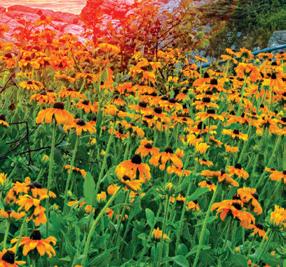



































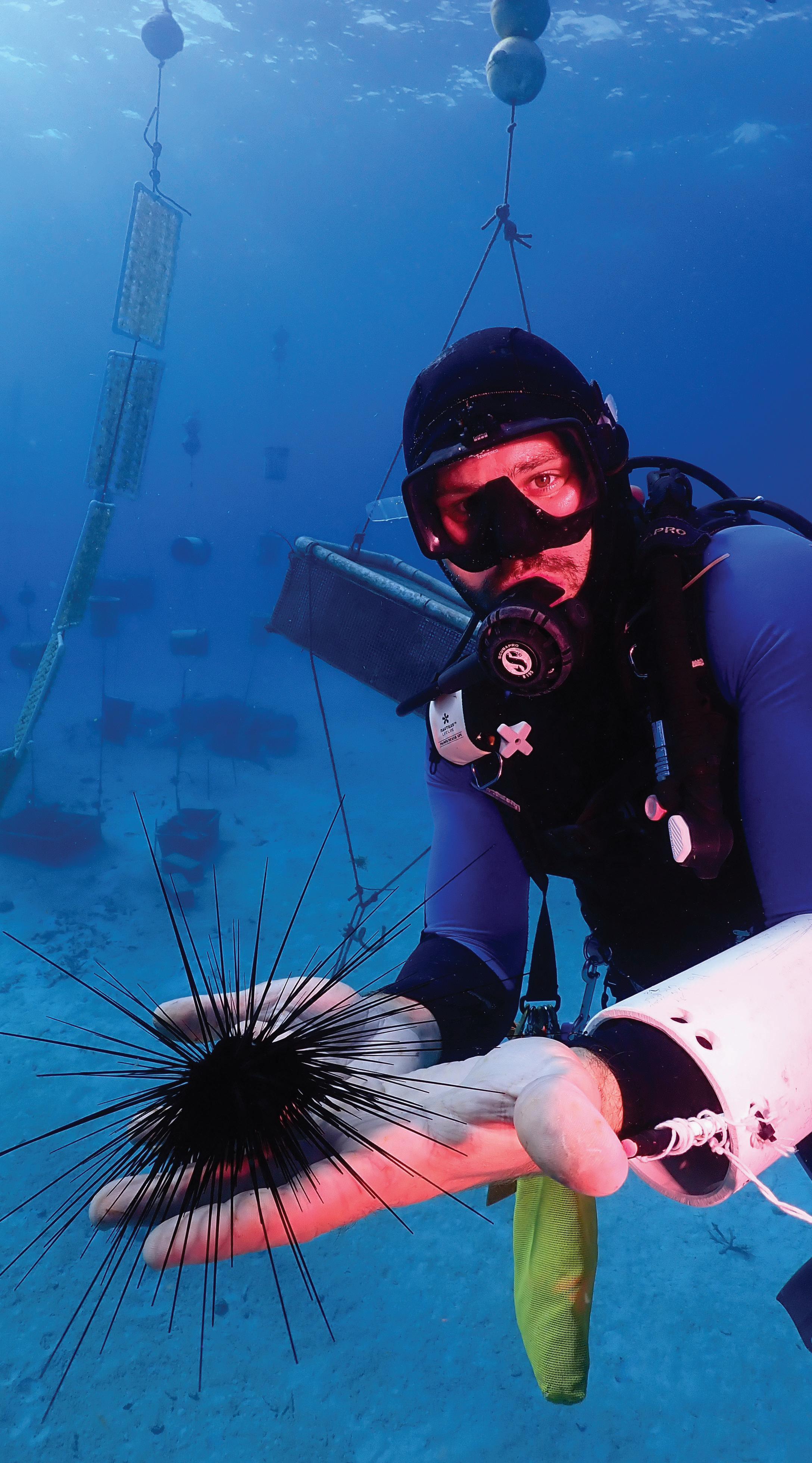
By Dan Eidsmoe
Beachcombers, scuba divers and snorkelers typically avoid urchins. If you step on one or accidentally bump into it, your skin can be punctured by the creature’s needle-like spines. Once under the skin, the spines are difficult to remove.
Florida Keys marine biologist Jim Brittsan, however, is excited by the round spiny creatures. As he explains, a healthy urchin population in the Caribbean is vital to the health of coral reefs.
Jim, 27, works with multiple coral restoration organizations throughout the Keys. Beginning as a selffunded project, he now has financial support from the state of Florida and is raising urchins in the wild with hopes of reintroducing them to Florida’s coral reef.
Urchins are important to the reefs because they eat algae. Out-of-control algae growth kills coral reefs by cutting off room for growth and diminishing the amount of sunlight and oxygen reaching the coral.

Jim says urchins are like underwater gardeners.
“When sea urchins consume










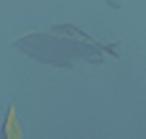






















algae, they create open spaces on the reef that can be colonized by new coral babies,” he says.
Algae growth and coral bleaching have decimated coral reefs. The Keys have lost 80% of their coral in the past 30 years. Many factors are believed to contribute to coral bleaching worldwide, including pollution, climate change, warming oceans and overfishing. In the Keys, water temperatures are frequently over 85 degrees in the summer. That high water temperature prompts algae growth that can smother coral and inhibit the settlement of coral larvae.
Jim, a Columbus, Ohio, native, is so optimistic about the prospects for raising sea urchins that he turned down scholarship opportunities for graduate studies in Puerto Rico and at Bowling Green University in Ohio.
Jim’s father, Mike, was the Columbus Zoo and Aquarium curator. As a student at Bowling Green University, Jim learned that everything in nature is interconnected.







































“If our oceans die, life in Ohio and landlocked states would also be adversely affected,” Jim says. “I knew coral reefs were in trouble, and I learned how important urchins were to the entire equation.”
Jim says the well-being of sea urchins has never been more important than now. Although once seen as a nuisance, the long-spined urchins are known as the greatest grazers of the Caribbean and caretakers of coral reefs.
The problem is, they are dying throughout the Caribbean. According to the National Park Service, long-spined sea urchins commonly live between the shoreline to depths over 100 feet. At low tide, they take shelter from waves in rock cavities. Although protected by the Florida Fish and Wildlife Conservation Commission, their numbers throughout the Keys have never been lower. Some scientists blame a microscopic, single-cell parasite for the die-off, which took hold in early 2022, but the resarch continues.
Jim describes one sea urchin species, Diadema antillarum, as a keystone species for Caribbean coral reefs. Before 1983, it was the most prevalent herbivore in the Caribbean. Today, it is nearly nonexistent.
“A diverse population of herbivores is important for maintaining a healthy balance between algae and coral on the reef and for supporting the many other organisms that rely on this ecosystem,” he says. “By restoring populations of different herbivorous species, we can help to support the health and resilience of Caribbean coral reefs.”
Jim hopes his urchin “babies” growing in an environment closely replicating the coral reef learn to eat algae off coral before being placed permanently into the wild. Every 15 to 30 days, he collects coral rubble covered in algae from the coral nurseries and puts it into the nursery with the baby urchins.
By grazing on the rubble, the young urchins learn to hide in the nooks







and crevices of the reef. They also eat everything in their path, not just the algae.
“The dead coral has many things growing on it,” Jim says. “In this setting, the urchins get a much more diverse diet of alga types. They also get bits of calcium carbonate from the rocks, which makes their spines hardier and increases spine density.”
In Jim’s nursery—the first of its kind in the Keys—coral trees and urchin shelters hang on monofilament lines tethered to the ocean floor and are held upright in the water by a buoy. The nursery integrates repurposed materials such as ice cream buckets, crates, ceiling tiles and Gatorade bottles. The cages, which Jim designs, are made from vinyl-coated wire and PVC frames. Sea water can pass through the boxes while protecting the growing urchins from fish predators.
“We hope to create a low-cost method to rear thousands of these herbivores,” he says. “A mariculture system like ours could be a game changer.”
With hopes high for the success of his urchin family, Jim is optimistic he may be able to leave coral reefs in a healthier place.
“With this project, I get the strong sense that I can be part of the solution rather than the problem,” he says.
Virtually visit the nursery in this three-minute video: bit.ly/sea_urchin_nursery.








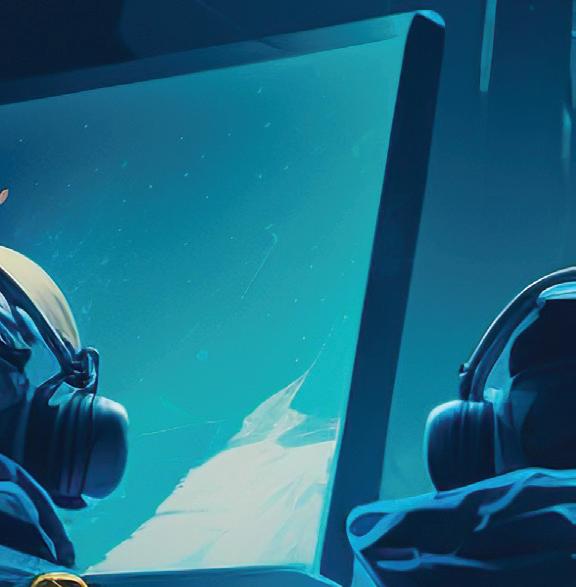



























Esports growth offers Florida students community and opportunity







By Drew Woolley
When Ryley Griffin arrived at the Florida Institute of Technology in 2018, he was excited to pursue a chemical engineering degree while playing lacrosse for the Division II school. It wasn’t long, however, before he discovered the rigor of his studies and the time he needed to dedicate to the team weren’t a good mix.







Still, Ryley knew he was competitive by nature. In 2019, another game captured his imagination.
“I realized I was going to go insane if I wasn’t part of a team or doing some kind of competition,” he says. “I was very in love with a game called League of Legends. I had played in internet cafe tournaments with my friends in high school. I decided to try and start a team with Florida Tech, who at the time was actually looking at doing esports.”
Florida Tech had just begun consulting

with Dana Hustedt, the director of esports at Grand View University in Iowa who helped build one of the country’s first collegiate esports programs in 2017. She provided a checklist of tasks that needed to be completed if Florida Tech wanted to create a robust program of its own.



In 2021, Florida Tech hired Dana as director of its esports program.
Since then, the program has assembled varsity and junior varsity teams for games such as League of Legends, Super Smash Bros., Rocket League and Valorant, while also building a welcoming community for noncompetitive gamers and establishing a two-story Esports Center on campus.
“Being a tech school, there’s always going to be that overlap of STEM students and video games,” Dana says. “It’s a way to engage their student population if you aren’t excited about regular sports or debate or other extracurriculars. This is a way that many students now relate with

gaming as a community factor.”




As a former student-athlete, Dana—who played varsity softball at Grand View University—often describes esports to newcomers in traditional sports terms. The playing field might differ, but many of the skills required are the same, from highlevel communication to rapid-fire decision making.
“Take a game where there are five players on a team,” she says. “Like basketball, they all have a position or a lane. Every one of them has their own unique skill set and fundamentals they need to do during the game. And the preparation that takes is very similar.”
Ryley found the same to be true when he first discovered League of Legends. In high school, he entered weekend competitions with friends at a local Microsoft store, where they played for
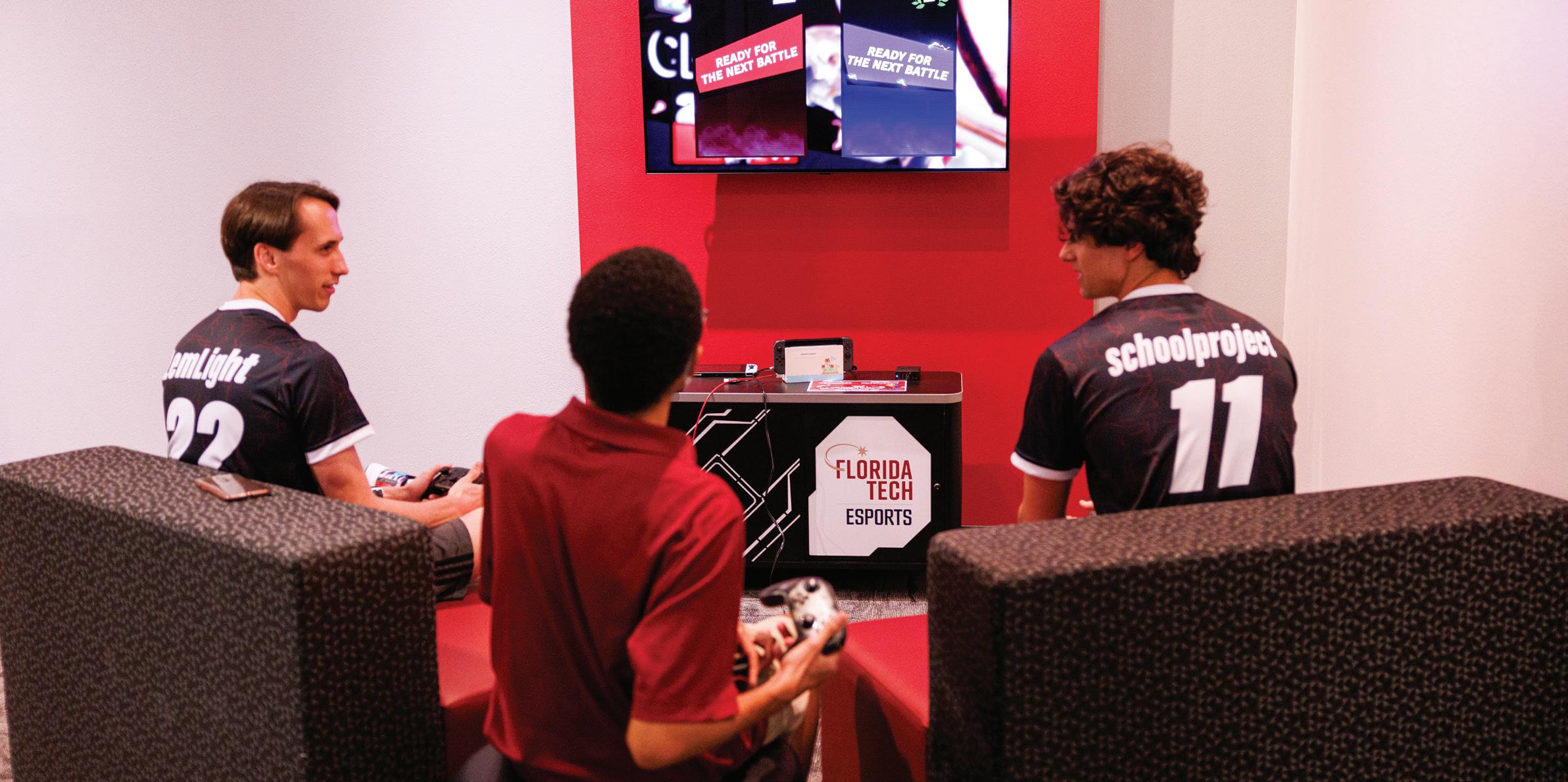





prizes, such as a new computer mouse.
“That’s where I fell in love with the competition,” he says. “I remember one day, we actually got to the finals, but we lost. None of us had any idea what we were doing, but we had a great time. I was there until 9:30 at night, so I got home, and my parents were like, ‘Where have you been?’ And I was like, ‘But I almost won.’”
After those amateur adventures, the Florida Tech team’s play was a harsh but welcome change of pace. Ryley says the

and there’s a software update for League of Legends. Now, my strategy is gone. Whatever champion I was going to play is out the window, and I have to figure something out in 30 minutes before we get into the game.”

transition to learning how to play a more organized game against far better players taught him the value of persistence. It also highlighted the importance of thinking on his feet, sometimes even more than when playing lacrosse.
“With traditional sports, you have all this training, and it almost becomes who can stick to a routine the longest and become the strongest from it,” he says. “But in esports, it’s so volatile. There are times when I’ve shown up to game day
In addition to cultivating adaptability, Florida Tech’s esports program is also designed to overlap with some of the university’s academic programs. The school’s Esports Center doubles as a home for the cybersecurity department, hosting classes, competitions and visits from prospective employers.
The esports program also works closely with the School of Behavior Analysis, with students observing verbal and nonverbal player behavior to monitor teams and offer workshops that help players develop as competitors and people.
“We don’t actually have a game design program or game animation as a major with us,” Dana says. “But we’ve used currently existing departments to see how can they also come into the gaming space with us. With the School of Behavior Analysis, the data that we’ve been collecting over the last three years hasn’t been taken anywhere else. So that’s really exciting in itself.”
Dana is excited to see the esports program serve as a gateway for visiting students who might not have known about the opportunities available at Florida

CLOCKWISE FROM ABOVE: Even for players who don’t compete on a team, the esports program can be an outlet for relieving the stresses of school and life. Florida Tech invested in a two-story, 5,800-squarefoot esports facility to give the program room to grow. A group of students gathers for a round of Super Smash Bros. PHOTOS COURTESY OF FLORIDA TECH ESPORTS
Tech. Drawn in by their interest in gaming, they might discover behavioral analysis only to find they also enjoy working in the same field with kids.
“Instead of working at a hospital, you might be able to get your research hours here through esports,” she says. “So that’s one really cool aspect that we can start to recruit people with. And it’s the same with cybersecurity. If your classes are taking place in a really cool gaming facility, that’s also a plus.”
Now a graduate student in Florida Tech’s chemical engineering program, Ryley says he routinely draws on his esports experiences as motivation in his academic work. As a researcher, esports has taught him to look for new solutions to a problem, even if everyone else approaches it the same way.
“You’re not going to get it right
the first time, and you’re probably not going to get it right the fifth time,” he says. “Even if someone else is doing it better than you right now, you can do it better than them later. It’s the same in school. You’ve got to allow yourself to not be thinking so rigidly about the world around you.”
Even if students don’t want to compete, participating in a robust esports program allows them to share their passion, connect with others and discover new opportunities, whether on campus or remotely.
“I think it gives those kids who don’t necessarily relate to traditional sports—who maybe don’t like watching football or soccer—it gives them something to be invested in and to have school spirit about that they might not normally have,” Ryley says. “I have Dana to thank because I’ve had some amazing years of my life because of the hard work she’s put in.”
While there are thousands of video game titles out there, a competitive game needs to have a certain amount of publisher backing so players know it will be around even as popular trends change. If you’re not game-savvy, the lineup can be confusing. Here are a few of the most popular:
League of Legends is a strategic multiplayer online battle set in a virtual arena. It’s a gaming staple, complete with diverse champions, complex strategies and a global following. The annual world championship keeps interest and participation high.
Combining soccer with rocket-powered cars, Rocket League has carved an esports niche. Gameplay is fast-paced and requires skill, with tournaments showcasing acrobatics and precise teamwork.
Nintendo’s iconic brawler features a roster of well-known gaming characters for competitors to use. Its gameplay is accessible for newcomers, but it has the depth needed to keep the attention of longtime players.
This tactical first-person shooter challenge requires precise gunplay and unique strategies. Its team-based action is great for tournaments and is an esports favorite.
Building on the success of its predecessor, Overwatch 2 includes diverse heroes and focused gameplay. It continues to be a favorite in esports. The game highlights the collaboration and skills of five-person competitive teams. The Overwatch League has franchises worldwide.





Graham Cracker Picnic Mix
¼ cup vegetable oil
¼ cup sugar
5 to 6 drops pink neon liquid food color
½ cup unpopped popcorn kernels

1 package mini pastel marshmallows
1 cup bear-shaped graham crackers
1 package white fudge-covered pretzels
1 cup mini cookies
In a large pot over medium heat, stir oil, sugar and food coloring. Stir in the popcorn kernels. Cover. Cook until popcorn begins to pop. Shake pot over heat until popping slows.
Remove pan from heat. Pour popcorn into a large bowl. Add marshmallows, graham crackers, pretzels and cookies. Toss lightly.
8 cups popped popcorn
2 tablespoons raspberry jam
3 tablespoons smooth peanut butter
½ cup white chocolate chips
¼ cup freeze-dried strawberries
¼ cup dried cranberries
In a large bowl, stir together popcorn and jam until evenly coated. Transfer to a parchment paper-lined baking sheet. In a double boiler over barely simmering water, add peanut butter and white chocolate chips. Cook, stirring occasionally, for 3 to 5 minutes, or until smooth and melted.
Drizzle peanut butter mixture over the popcorn mixture. Sprinkle with strawberries and cranberries.
Refrigerate for 10 minutes or until the peanut butter mixture is set. Break into pieces to serve. Store in an airtight container in the refrigerator for up to one week.
6 quarts popped popcorn
Olive oil cooking spray
1 cup grated Parmesan cheese
2 teaspoons garlic salt
2 teaspoons paprika
1 tablespoon Italian seasoning
Place popcorn in a large, sealable plastic container or a 2½-gallon plastic sealable bag.
Spray popcorn lightly with cooking spray. Sprinkle cheese, garlic salt, paprika and Italian seasoning over popcorn. Shake to distribute evenly.
12 cups unsalted, unbuttered, popped popcorn
4 cups mini marshmallows
2 tablespoons butter or light olive oil
½ teaspoon salt
1 tablespoon green food coloring
¼ teaspoon peppermint extract
1 cup green candy-coated chocolate candies
Place popcorn in a large mixing bowl. In a saucepan over medium heat, melt marshmallows, butter and salt. Stir occasionally until smooth. Remove from heat. Stir in food coloring and peppermint extract.
Toss marshmallow mixture with popcorn. Cool for 2 to 3 minutes or until cool enough to handle. Toss with chocolate candies.
Shape 3 tablespoons of popcorn mixture into a small cluster. Place on a wax paper-lined baking sheet. Repeat with the remaining popcorn mixture. Cool completely.
¼ cup freeze-dried strawberries, ground
6 cups popped popcorn
1 cup white chocolate chips, melted
In a small food processor or spice grinder, pulse freezedried strawberries until finely ground.
Place popcorn in a large bowl. Drizzle melted chocolate over the top. Toss until well-coated. Sprinkle evenly with ground strawberries. Toss until well-coated.
Scrape popcorn onto a large parchment paper-lined baking sheet, spreading into an even layer.
Let stand at room temperature for 30 to 60 minutes, or until chocolate is set and hardened. To serve, break into pieces.
5 cups popped popcorn
12 ounces white chocolate chips or chopped white chocolate
1 cup crushed hard candy peppermints
Cover a baking sheet with foil or wax paper. Set aside. Place popcorn in a large bowl. Set aside.
In a double boiler over barely simmering water, melt chocolate, stirring until smooth. Stir in crushed peppermints.
Pour the chocolate mixture over the popcorn mixture. Stir to coat. Spread onto prepared sheet. Cool completely.
When chocolate is cooled and set, break into chunks for serving. Store in an airtight container at room temperature.
8 cups popped popcorn
½ cup chopped toasted pecans
1⁄3 cup maple syrup
1 tablespoon bourbon
2 tablespoons butter
1 tablespoon orange zest
1 dash bitters
Place popcorn and pecans in a large bowl.
In a small saucepan over medium-high heat, combine maple syrup, bourbon and butter. Bring to a boil. Cook, swirling pan, for 3 to 5 minutes or until mixture thickens to corn syrup consistency. Stir in orange zest and bitters.
Drizzle maple syrup mixture over popcorn. Toss to evenly coat. Cool completely before serving.
Options: Substitute bourbon with rye or whiskey. For mocktail popcorn, substitute with nonalcoholic bourbon or whiskey.

My heart is heavy.
One of the true blessings of writing a column is the opportunity to share with you, my readers, not only what I see but what is on my heart. The two are often interconnected. As trite as it sounds, I feel like we are family.
In the wake of the most recent war atrocities, it’s challenging to keep my attention on things like photography and positive storytelling. Yet, even as I wade through the

emotions of these conflicts, I am reminded what a lifelong gift photography is, distracting me from deep and painful events while acting as a vehicle to share what I see and feel. For this, I am forever grateful.
Armed with a purpose, photography has always been a powerful communication tool. With it, we can shine light in dark places or quietly applaud acts of love and goodness. I believe both are necessary. While I truly admire the courage of my friends who risk their lives to show us the injustices and atrocities of war, I have chosen to celebrate light and those who reflect it.
Where there is light, there is hope. The new year is the perfect time to talk about seeing and being light. Whether
literal or metaphoric, light reveals and heals. Each of us chooses how we use light. With our cameras, as with our words, we can choose to focus on the good and lovely in our world or dwell on the dark, ugly and evil.
I attended a seminar where the speaker reminded his audience of the difference between a thermometer and a thermostat. One reads the temperature, and the other changes it, he challenged.
The late Agnes Baker Pilgrim—also known as Grandma Aggie, a Native American spiritual elder I wrote about a few years ago— said she talked to water, thanking it often. She insisted water hears us. I think light is similar. I know it has a voice. n
Show me the goodness of light, as it falls on mountains, fields, streams, rooftops, bedsheets or kitchen sinks. Or, as it springs forth from the heart in acts of kindness.
Email your best image (just one, please) with caption information, including an explanation of how it affects you, to GPH@pur.coop. We may share submissions on our website and social media channels.
How can rechargeable hearing aids that t inside your ear costs only $297 and be every bit as good as those that sell for $4,800 or more?
The answer: The MDHearing™ NEO uses the same kind of technology incorporated into hearing aids that cost thousands more at a small fraction of the price. Satis ed MDHearing customers agree: High-quality, digital, FDA-registered rechargeable hearing aids don’t have to cost a fortune. NEO is a medical-grade, digital, rechargeable hearing aid offering sophistication and high performance; and works right out of the box with no time consuming “adjustment” appointments. You can contact a licensed hearing specialist conveniently online or by phone — even after your purchase at no cost. No other company provides such extensive support. Now that you know... why pay more? PLUS... It fits inside your ear.

































Looking like a miniature aircraft carrier riding on massive tires, the swamp buggy crawls along a field edge smashing through brush and high weeds near Lake Okeechobee in south Florida.
Instead of jets, this flattop carries a deck festooned with old automobile seats where hunters sit in comfort. One deck below, crates contain excited dogs.
A 250-pound feral boar erupts from cover. Wanting to trap the animal alive, we release dogs to chase this tusked mammal through briar thickets and dense underbrush.
Domestic hogs first came to North America with early European explorers. In 1539, Spanish conquistador Hernando de Soto landed near Tampa, bringing a large herd of pigs to feed his troops. Some pigs escaped into the wild and multiplied.
Today, the pigs’ descendants number in the millions and populate more than 35 states, with the highest concentrations of feral hogs found in Texas, Florida, Louisiana and California.
Many people consider feral hogs among the most dangerous mammals in North America.
Bristling with razor-sharp tusks up to 3 inches long, a wild boar can inflict serious injuries. Leaner and more muscled than barnyard pigs, boars can weigh more than 500 pounds, but average between 100 and 300 pounds. A coarse hide covering a thick shield of hardened scar tissue draped over its head and bony shoulders protects its vital organs.
With armor, a bad disposition and few natural enemies, adult boars fear nothing—except dogs.
In a good spot, hunters release one to three strike dogs, such as curs, redbones or walker hounds. They alternate dogs during a hunting day. Strike dogs sniff out the pigs and chase them, nipping the hogs’ tail or back legs to make them stop, face the pack and fight.
Once strike dogs bay a pig, hunters send in a catch dog, typically a strong-jawed pit bull, often wearing a spiked collar and Kevlar vest for protection. The catch dog grabs an ear, snout, other

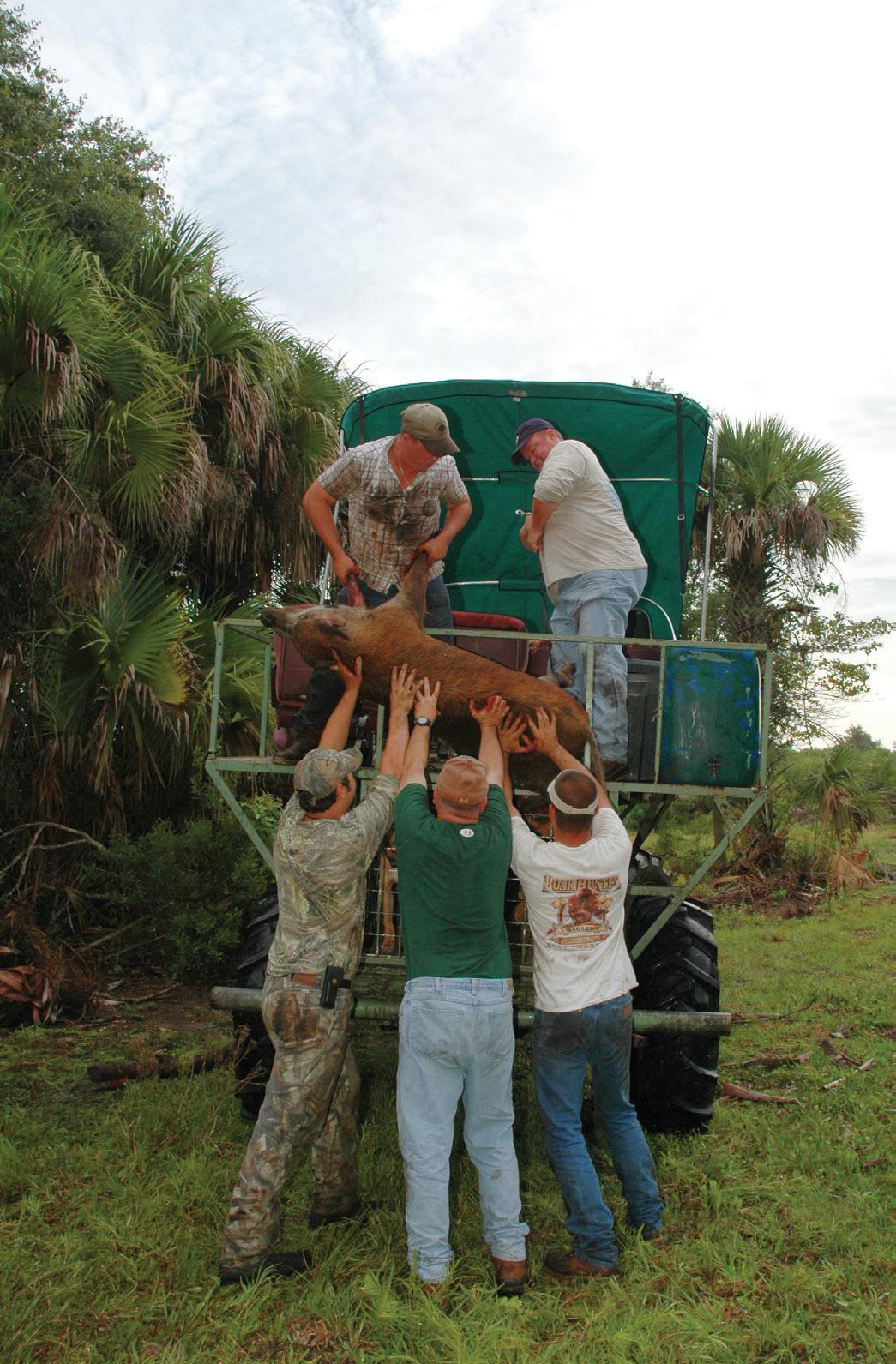
sensitive organ or whatever it can on an angry pig to immobilize it until the humans arrive.
After an exhilarating chase behind howling hounds and an adrenaline-pumping brawl at the bay, one or more hunters grabs the pig by its hind legs. This keeps it from moving and angles the porker’s head downward to prevent it from slashing people or dogs with its tusks.
With the pig held securely, someone kills it, customarily stabbing it with a large pig-sticker knife to avoid injuring any humans or dogs. Some people shoot the pigs with handguns.
Hogs populate every Florida county. The state allows hunters to hunt feral hogs all year on private lands. Some public properties allow people to shoot wild hogs as bonus game during other open seasons. The state even offers special hog-hunting opportunities on certain lands.
Because the highly prolific nonnative animals frequently destroy fences, eat crops and tear up wildlife habitat, many landowners welcome hog hunters onto their properties.
For more on Florida hog hunting, visit myfwc.com/hunting/ wild-hog.

John N. Felsher is a freelance writer, broadcaster, photographer and editor. An avid sportsman, he’s written more than 3,500 articles for more than 170 different magazines on a wide variety of outdoor topics. He also hosts an outdoor tips show for WAVH-FM Talk 106.5 in Mobile, Alabama. Contact him at j.felsher@hotmail.com or through Facebook.



Mighty Conifer Knife at an Impossible Price! $99 Impossible Price
What Stauer Clients Are Saying About Our Knives
“Outstanding knife of high quality and a great price. I now have a number of your great cutlery in my growing collection!”
— Robert F.,
Richardson, TX

e know you. You’re not interested in everyday, run-of-themill, common cutlery. You want something with a story, a unique feature that you can brag about. We’ve got just the thing for you. Our Mighty Conifer Knife is a unique tool with a Damascus steel blade and a handle crafted from an enhanced and stabilized natural pinecone. While our competitors are charging hundreds for similar knives, we’re offering the Mighty Conifer for JUST $99! That’s what we call our Stauer Impossible Price.


Join more than 389,000 sharp people who collect stauer knives EXCLUSIVE FREE
Each pinecone — and therefore, each knife — has its own unique characteristics. And the back of the handle features hand tooling, a further demonstration of each piece’s individual nature.
The blade is nothing to scoff at either. Constructed of Damascus steel, a modern reworking of the legendary steel forged by ancient swordsmiths, this nearly 5-inch blade features 256 layers of steel that have been folded on top of each other to increase its durability. Our competitors are charging hundreds for boring, run-of-themill knives with no features worth bragging about. We’re asking JUST $99 for a knife unlike any you’ve seen before!
With its full-tang construction and high-quality genuine leather sheath, the Mighty Conifer Knife is the perfect blade for the
person who wants to stand out. CALL NOW! If you’re one of the first 700 587 callers for this ad, we’ll throw in a pair of Stauer 8x21 Compact Binoculars — a $99 value — ABSOLUTELY FREE!
Satisfaction guaranteed or your money back!
Knife Specifications:
• 9 1/2" overall length. Full-tang construction
• Damascus steel blade and natural pinecone handle
• Genuine leather sheath
Mighty Conifer Knife
$299 $99* + S&P Save $200
*You must use Insider Offer Code: MCK145-01 to get this price.

Stauer 8x21 Compact Binoculars a $99 value with your purchase


California residents please call regarding Proposition 65 regulations before purchasing this product.
1-800-333-2045
Your Insider Offer Code: MCK145-01



All ages can find something new and exciting around every corner of the state. Filled with rich history, abundant natural beauty and diverse events all year, Florida has something fun for everyone.
January 1-16
First City Lights Festival
Navigate the eclectic historic district voted Florida’s Greatest Place as you experience live street performances, caroling in the streets and Winterfest Trolley Tours.
www.downtownpensacola.com; 850-434-5371
January 6 and 20
An Evening Under the Stars
Big Lagoon State Park, along with the Escambia Amateur Astronomer Association, invites you to spend an evening gazing at the skies. Clear skies permitting, telescopes and binoculars are set up to capture views of the moon, planets and other celestial objects. All participants must enter the park before sunset.
www.floridastateparks.org; 850-492-1595

January 13
Paws for a Cause
This dog walk to Pigeon Key benefits the Domestic Abuse Shelter of the Florida Keys. Registration begins at 8:15 a.m. at the beginning of the old 7-Mile Bridge. The walk starts at 9 a.m. Brunch is served on Pigeon Key. Bring your family and dog for a beautiful 4.4-mile walk.
305-849-6236
January 13
40th Annual Art Under the Oaks


January 6-7
Florida Keys Celtic Festival
This festival brings the rich cultural heritage of the Celtic nations to the heart of the Florida Keys. This family-friendly event features world-class musicians, performers, athletes, food, beer, and Celtic and Keys vendors. Children can enjoy arts and crafts, along with Highland Games events. This event is open 10 a.m. to 7 p.m. Saturday and 11 a.m. to 5 p.m. Sunday.
floridakeyscelticfestival.com; 850-529-0699

View fine art, original crafts and live entertainment in the San Pedro Church gardens. Enjoy refreshments, homemade bake sale goodies and raffles from 9 a.m. to 4 p.m. Admission is free, but onsite parking is $5. www.artundertheoaks.com; 305-852-5372, ext. 3








January 13-14
18th Annual Florida Keys Seafood Festival
Seafood and music combine yet again for this year’s festival at Bayview Park. From stone crabs and conch fritters to classic rock, this year’s festival brings timeless tunes and classic hits to the outdoor stage. Vendors are available for shopping, and a children’s area includes bounce houses and face painting. The $10 admission is good for both days. Children younger than 12 get in free.
floridakeysseafoodfestival.com; 305-743-0294


January 20
Kids and Kritters Mardi Gras Parade
This family-friendly Mardi Gras event is a walking procession for people and pets. The event begins at 1:30 p.m. in the Casino Beach parking lot with a pre-parade dance show. The parade begins at 2 p.m. www.pensacolabeachmardigras.com; 850-748-6878
January 21
12th Annual Tea
Enjoy an afternoon of dining on tea sandwiches, fruit breads and decadent desserts. Join the fun with the Country Girl Dress Up contest. Doors open at 1 p.m. and tea hours are 2 to 4 p.m. Tickets are $25 and can be bought at the Caladium Arts and Crafts Co-Operative, 123 Interlake Blvd. www.caladiumarts.org; 863-699-5940
January 26-27
Trash and Treasure Sale


The St. James Council of Catholic Women sponsors its annual Trash and Treasure Sale at the church’s Social Hall, 3380 Placid View Drive. The sale is one of the largest in the area with clothing, housewares, furniture, tools and fishing equipment included. Doors open at 8 a.m. and close at 2 p.m. Friday and 1 p.m. Saturday. www.stjameschurchlp.com; 863-465-3215
January 27
Pops in the Park
The Florida Keys Community Concert Band invites you to attend this free band concert in Peace Park. January’s event is Looney Tunes—Heroes and Villains. Pack a picnic basket and blanket or chairs, and load up the family and furry friends for this night of music. keyscommunityconcertband.org; 305-294-1123


January 15, 22 and 29
Florida Keys Concert Series


Delirium Musicum is a self-conducted, ethnically diverse chamber orchestra from Los Angeles composed of some of classical music’s top up-and-coming young artists. Other dates include January 22 with cellist Zlatomir Fung and January 29 with Shelest Piano Duo. Concerts start at 7:30 p.m. in the Marathon High School auditorium. www.floridakeysconcerts.com; 800-324-6982
January 27-28
Peace River Pro Rodeo Classic
Rodeo fans come to the Heartland of Florida and watch professional cowboys and cowgirls from across the nation compete. Gates open at 5 p.m. Saturday and noon Sunday at Hardee County Cattlemen’s Arena. Food and clothing vendors are onsite. www.peaceriverprorodeo.com; 863-773-4132



Want to share a family-friendly event with the readers of Florida Currents? Send details in an attached Word document (no PDFs, please)—in the format shown on this page—to info@floridacurrents.com. Include the date, town, times and a way for readers to register or get more information. Make sure to submit the item at least 60 days before the event (due to press deadline). If you own rights to a print-quality photo promoting your event— perhaps from a past year—include it with photo credit information.






Crapemyrtle is a versatile, drought-tolerant tree that produces dazzling blooms all summer long.
The tree is also a living sculpture during the winter, adding form and texture to the landscape. Late winter is the optimal time to prune crapemyrtles.
It’s important you know how to prune correctly so you can avoid topping—a practice commonly known as “crape murder.”
To properly prune crapemyrtles, use the following techniques:
• Remove suckers (small sprouts that develop along main stems or roots).
• Remove crossed, damaged or diseased branches. For crossed branches, remove the weaker of the two limbs that are crossing or rubbing.
Unfortunately, many homeowners and landscape professionals prune crapemyrtle trees too severely.
Topping can damage the tree and results in a “witch’s broom” appearance. Following this, the tree is no longer in proportion. Although topping may result in larger blooms, the flowers grow on thinner, weaker branches that droop and may even break. Topping can also shorten the life of the tree.
If you want to rehabilitate a “murdered” crapemyrtle, try one of the following options:
• Choose the strongest two sprouts from each stub, and remove the rest. This encourages remaining sprouts to grow stronger and opens the canopy of the tree. If you follow this procedure for a few seasons, the tree should improve in health and appearance.
• Cut the tree back to between 1 to 2 inches of the ground while the tree is dormant. After two to three weeks of growth, select three to five of the most vigorous new shoots on each trunk and remove all others. Remove any new shoots that emerge later. Within three to five years, you should again have a natural-looking crapemyrtle.
Spread the word to help eliminate crape murder. Use proper pruning techniques on your own trees or ask your yard maintenance professionals about their pruning techniques. Choose an appropriately sized plant for your site and prune sparingly to maintain beautiful crapemyrtles in your yard.
The UF/IFAS Florida Master Gardener Volunteer Program focuses on educating citizens about the science-based landscape and gardening information developed by the University of Florida. These volunteers share this knowledge with people in their communities to help conserve water, protect natural resources, and improve the lives of Florida residents. Visit UF/IFAS Gardening Solutions at gardeningsolutions.ifas. ufl.edu for more information on gardening in Florida.


Peace River Electric Cooperative is excited to announce the newest addition to our leadership team, Teresa Hamilton, who has joined us as the vice president of Finance and Administration. In her role, Teresa oversees crucial functions such as accounting, finance, human resources, purchasing and loss control.
Hailing from northern Kentucky, Teresa brings a wealth of experience and expertise to the cooperative. Before joining PRECO, she served as the vice president of accounting for Owen Electric Cooperative in Owenton, Kentucky.
Teresa studied at the Florida Institute of Technology, where she earned her undergraduate degree in accounting. Committed to furthering her knowledge, she completed a master’s degree in business administration with an emphasis on accounting from the University of the Cumberlands.
With her husband, Jim, Teresa moved to Florida to embrace a lifestyle that allows them to spend more time outdoors. They share a love for exploring rural areas, appreciating community arts and attending sporting events. The Hamiltons have three adult children: Cassie, Cole and Joe.
Beyond her professional achievements, Teresa’s goals center on continual learning, living in the moment and enjoying life’s journey.
At PRECO, we believe Teresa possesses the qualifications and dedication to propel the co-op forward. Her vision and knowledge make her an asset to this fast-growing electric distribution utility. We know Teresa will enhance our services and create lasting benefits for our members.
Welcome aboard, Teresa! We look forward to a successful journey ahead. n





Peace River Electric is a member-owned electric distribution cooperative. As part owner of the co-op, you have a voice in who serves on PRECO’s board of directors.
To ensure strong local leadership, members elect directors on a rotating basis from each of PRECO’s nine districts. In 2024, terms are expiring for districts 2, 5 and 8. Your district number is printed on your electric bill. See the map below.



Terms expiring in 2024: Districts 2, 5 and 8




Any person who meets the qualifications in the PRECO bylaws is eligible to serve as a director. For a list of director qualifications, refer to Article IV, Section 2 of the cooperative’s bylaws. Copies are available at any PRECO office or online at PRECO.coop/about/bylaws.
Section 5. Elections
One Director shall be elected from each District not less than fifteen (15) days or more than forty-five (45) days prior to the expiration of the current term of each District Director.
(a) Nominations of Director Candidates
Nominating Committee Nominations
At least one hundred twenty (120) days before the expiration of the current term of each District Director, the Board of Directors shall appoint a nominating committee consisting of not less than three nor more than five members residing in the District. No member of the Board of Directors may serve on such committee. The nominating committee shall meet at least ninety (90) days before the expiration of the current term of each District Director and nominate at least one qualified individual to run for election as Director. If, before the scheduled election, a nominating committee nominee dies, becomes incapacitated or ceases to be qualified to be a Director, then the nominating committee may nominate another individual.
Member Petition Nominations
Members may nominate, through petition, a qualified individual to run for election as Director. Member petition nominations must be delivered to the Cooperative at least seventy-five (75) days before the expiration of the current term of office of each District Director. Valid petitions shall:
1. List, on each page of the petition, the name of the nominee and the Director position for which the nominee will run; and
2. Contain the printed names, addresses, and original dated signatures signed within thirty (30) days after the first signature of at least twenty-five (25) members of the District.
All Director candidates are required to execute a notarized affidavit affirming their compliance with the Director qualifications as described in Article IV, Section 2, of the bylaws.
If more than one qualified Director candidate accepts the nomination for a Director position, the Director shall be elected at a District membership meeting. The Board of Directors shall call and set the date of such meeting. The Secretary of the Cooperative shall send a notice to each member residing in the District not less than ten (10) days before the meeting announcing the names of all qualified
Director candidates and the date, time and place of the District membership meeting.
One percent (1%) of the members of the District shall constitute a quorum for any District Membership meeting at which an election is required. Upon a member being present for any purpose at the member meeting, the member is deemed present for member quorum purposes for the remainder of the member meeting and for any adjourned member meeting. If less than a quorum is present at any District membership meeting at which an election is required, a majority of those present in person may adjourn the meeting to a date no less than fifteen (15) days before the annual meeting.
The Board may appoint any member of the Board of Directors to act as the Chairman and preside over any District membership meeting. If the Board fails to appoint, or the appointed chairman is unable to attend, a Chairman may be selected from the members present. A Secretary for said meeting may be furnished by the Cooperative or selected by the members present and shall record the proceedings of said meeting.
At the beginning of the District membership meeting, the Chairman shall inform the members present of the qualified Director candidates who have accepted the nomination. There shall be no additional nominations from the floor. The meeting shall then proceed to the holding of an election for Director. Each member present and in person at the District membership meeting shall be entitled to one vote.
Upon voting for the Director candidates, the candidate receiving a plurality of votes cast by those present and qualified shall be declared by the Chairman to be the Director-elect and shall be seated at the annual meeting of the Cooperative.
In the event of a tie vote, the winner of a coin toss shall be declared Director-elect.
If only one qualified Director candidate is nominated or accepts nomination for a Director position, the Cooperative will dispense with balloting, no quorum will be required, and the candidate will be declared the Director-elect at the District membership meeting.
The good faith, inadvertent and unintended failure of a member to receive notice of a District membership meeting does not affect an action taken at the District membership meeting. The Cooperative’s attorney shall have the authority to rule upon all questions that may arise relating to member voting and the election of Directors.
Sometimes, there are no words to describe your day—good or bad. Other times, days are long and tiring, so who wants to spend energy writing at the end of the night?
However, if you’re set on journaling in 2024, there are still options that can turn that dread into excitement.
Try taking writing out of the mix. Journaling doesn’t have to include words. Focus on visuals: drawing or doodles, graphs, daily Polaroids or creating pixels.
Documenting the year in pixels has been a favorite among bullet journaling in the past few years. Follow these six steps to set yourself up for an easy year of journaling:
• Find a piece of paper. This could be within a journal or a standalone piece. Keep it where you can find it at the end of the day.
• Choose five to 10 colors from your set of colored pencils, pens or markers. The medium you choose depends on how vibrant you want your pixels to be. Pens and markers tend to be brighter.
• On your piece of paper, draw a horizontal line at the top of the paper and a vertical line along the left side. Draw an additional 31 horizontal lines going down the page and 12 vertical lines across the page, creating little squares that become pixels as they

month above the columns. Along the left side, number the rows one to 31 downward.
• To the right side of the page, create a key. Match a color with an emotion or state of mind you were in that day.
• List emotions or states of mind you might feel throughout the year. Some useful ones are: good, happy, normal, routine, productive, lazy, unmotivated, angry and sad. To the left of these words, assign a color. You can choose as few or as many colors as you would like for your year.

SHE FOUGHT FOR HER COUNTRY. IT’S OUR DUTY TO FIGHT FOR HER.

Wounded Warrior Project ® long-term support programs provide these brave men and women whatever they need to continue their fight for independence. At no cost. For life. Help us help more of these warriors in their new life-long battle. Find out what you can do at fi ndWWP.org.




















































PRECO.coop
800-282-3824
to report a power outage
Use the SmartHub app.
Text OUT to 800-282-3824.
Call 800-282-3824.
corporate headquarters
210 Metheny Road
Wauchula, FL 33873
manatee service center
14505 Arbor Green Trail
Lakewood Ranch, FL 34202
board of directors
District 1
LEONARD CRAWLEY
District 2
KENNETH ODEN
District 3
BRUCE VICKERS
District 4
HOLLIS ALBRITTON
District 5
MARIE DASHER
District 6
JOHN MARTIN
District 7
CHRIS PORTALE
District 8
ELLEN BACHMAN
District 9
WILLIE DAWES
board meetings
January 23, 2024
February 27, 2024
March 26, 2024
Any PRECO member may attend board meetings. Due to building security requirements and to facilitate attendance, members should contact the cooperative in a timely manner for logistical information regarding meetings.
online e-zine
Prefer to receive Florida Currents online?
Sign up through your online account or call us at 800-282-3824
CEO Message
Power lines. They deliver electricity to homes and businesses and are essential to our modern way of life. We see them everywhere, so we sometimes forget they can be potentially dangerous. Myths abound when it comes to power line safety. To help protect our communities, Peace River Electric Cooperative believes it’s crucial to end power line misconceptions.
Myth 1: I’m safe as long as I don’t touch power lines.
One of the most common myths about power lines is the belief that you’re safe as long as you don’t physically contact them. Power lines can energize the air around them. If you get too close, electricity can arc (jump) to you, leading to possible injury or death. Therefore, stay far away from power lines.
Myth 2: If birds can sit on power lines, it’s safe for humans.
Birds often perch on power lines without harm. Since there is no difference in voltage in the short distance between a bird’s feet, no circuit is created, and no electricity flows through its body. However, an electric shock occurs if a person touches a power line while touching the ground or another conductor.
Myth 3: Wooden ladders are safe around power lines.
Some believe using a wooden ladder protects them when working near power lines. Wood is not a sufficient insulator when it comes to electricity. Only use nonconductive ladders around power lines and maintain a safe distance from them.
Myth 4: It’s safe to trim trees near power lines.
Trimming trees near power lines should only be performed by trained professionals. The risk is too great for anyone else. Falling branches could strike power lines and you at the same time, causing physical harm or death.
Myth 5: Power lines are insulated, so they’re safe to touch.
Power lines are typically not insulated with a protective covering like household wiring. Touching a power line, even if it appears insulated, can deliver an electric shock. Always assume that power lines are energized and avoid any contact.
Understanding power line safety helps prevent accidents and protect lives. PRECO promotes a culture of awareness and safety by encouraging everyone to play it safe with electricity.
